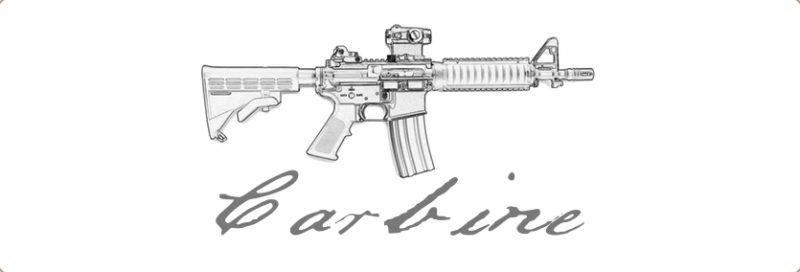Carbine Qualification Test
Overview
This is our modern carbine skills test. It requires scoring hits in a variety of positions against targets at known distances. This event is ideally fired on a 100 yard range, although options to use scaled targets for some stages make this viable on a 25 or 50 yard bay as well.
We use this skills test at Rifle 223 carbine events.
This event is conducted in the NRA AR Challenge “Basic Match” format. The final stage may be conducted in the “advanced match” format which means that shooters go one at a time with RSO supervision, allowing for a more dynamic experience.
History
This skills test is based on the traditional WW2 M1 carbine qualification course of fire from FM 23-7 dated May 20, 1942 supplemented by the qualification scores from AR 775-10. It was originally fired on partial “A” and “B” type targets at 100, 200, and 300 yards.
We have simplified the scoring. The WW2 marksmanship standards emphasized accuracy over speed, so we have modified the course of fire to add more modern elements in keeping with the NRA AR Challenge theme and goals. At some events we still offer the pure WW2 challenge as the “Classic Carbine” format.
Targets
All stages are fired on a Revere’s Riders carbine target. The carbine target features two scoring areas. The main scoring area is equivalent to a 10.5″ circle. The small “T” shaped scoring area is about 12 sq inches.
Practice targets are available to sustaining members at the Member’s Resources page.
Stages
| Stage | Range (Yards) | Time (Sec) | Target | Rounds | Remarks |
|---|---|---|---|---|---|
| 1A | 7 | 3 | Both | 3 | Designated Failure to Stop. Two rounds to large, one to small. |
| 1B | 7 | 3 | T | 1 | |
| 2A | 15 | 3 | Large | 2 | Optional Failure to Stop. |
| 2B | 15 | 3 | T | 1 | From the high ready. |
| 2C | 15 | 3 | T | 1 | |
| 3A | 25 | 3 | Large | 2 | Optional Failure to Stop. |
| 3B | 25 | 3 | T | 1 | From the high ready. |
| 3C | 25 | 3 | T | 1 | |
| 4 | 50 | 20 | Large | 2+2 | Fire 2 rounds standing. Transition to kneeling, reload, fire 2 more rounds. |
| 5 | 100 | 20 | Large | 2+2 | Start with type one malfunction. Clear type 1, fire 2 rounds prone. Reload, fire 2 more rounds. |
| 6 | Varies | 5-20 | Varies | 0-5 | Go/No-Go Scoring. Optional. |
On stage four, the shooter starts standing and fires two rounds. They then transition to the kneeling position and conduct a speed reload before firing two more rounds. All transitions between positions are to be conducted from a bolt locked open on an empty chamber with safety on. Shooters will load only two rounds in the first magazine for the standing portion of the stage.
Special Procedures:
- Optics (if used) must begin with at the lowest power setting. Iron sights with multiple flip apertures begin with the large aperture in place. The sights may be adjusted once time begins.
- Shooters may not begin the stage “slung up.” A hasty sling may be used for support but the shooter must get into the sling on the clock.
- Bipods (if used) may not begin in the deployed position; they must be deployed on the clock. If used, the bipod must remain mounted through the entire course.
- All firing is from the “ready” position, unless the “high ready” is indicated. The prone stage begins from the prone position, pointed in.
- Scanning: Shooters should scan the environment after each stage and are required for reloads as required between stages.
As a default for Stage 6, “Morgan’s Challenge” is used. This is a single shot against a shingle at 100 yards replicating a Revolutionary War challenge. However, Event Directors may use a different challenge, to include an “advanced format” event where shooters go one at a time under RSO supervision with some movement.
Scoring
Hits count for one point. Stage six is used as a tiebreaker if needed.
| Marksman | Sharpshooter | Expert | Master |
|---|---|---|---|
| 15/20 | 17/20 | 18/20 | 20/20 and “Go” on final stage |
Shooters who score as “sharpshooters” or better receive a “carbine” certificate and patch. These score cutoffs are based on the WW2-era qualification standards.
Shooters are are consistently scoring as “sharpshooters” on this event are well prepared to try their hand at a wide variety of carbine events, to include CMP’s M1 Carbine matches or the NRA America’s Rifle Challenge.
If reporting scores as an NRA AR Challenge, then different classes may be used for iron sights, optics, or multiple optic systems in accordance with the AR challenge guidebook.
Variants
- 25 or 50 Yard Bay: In order to avoid moving the firing line, and to allow use at ranges that only allow firing at reduced distances, we have a variant with scaled targets that allow the 50 and 100 yard stages to be fired at reduced ranges
- Double Round Count: We use a 40 to 50-round variant which also exercises the seated position and different readies.





You must be logged in to post a comment.